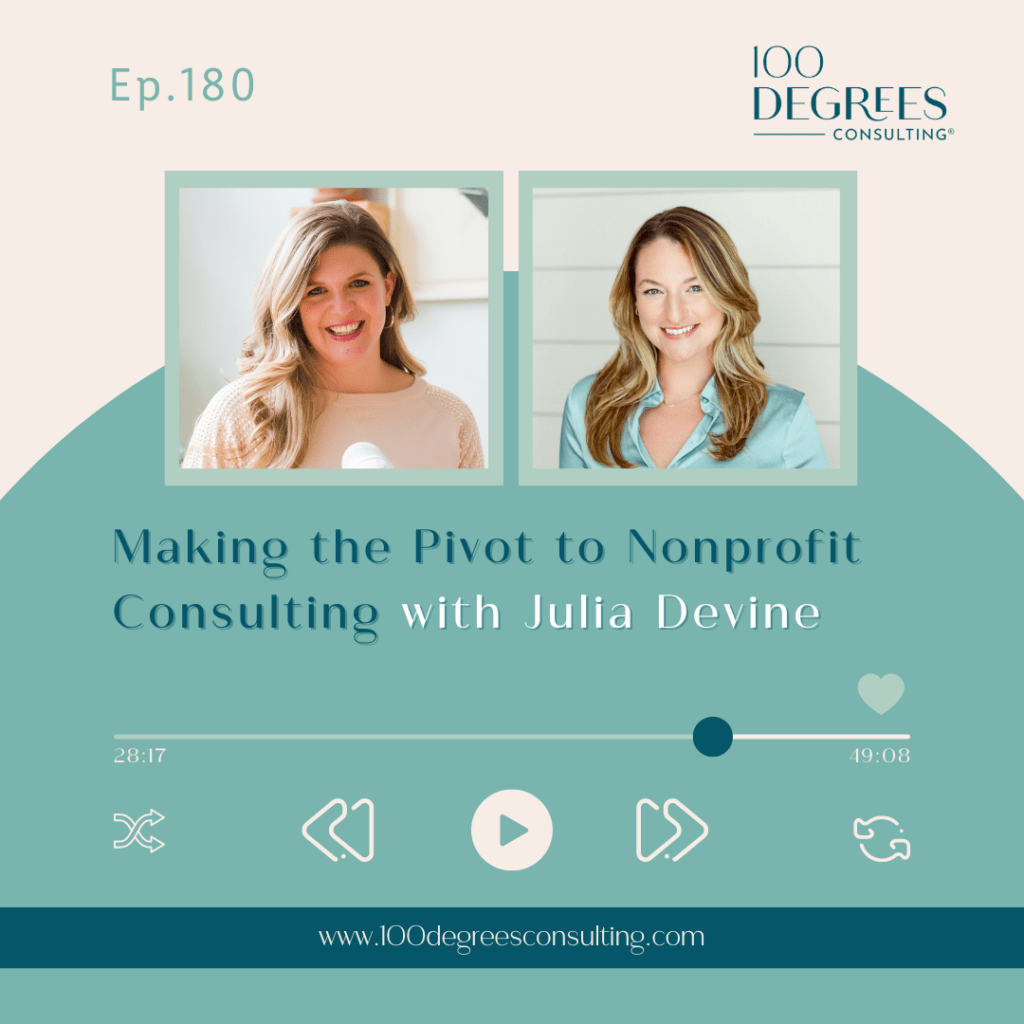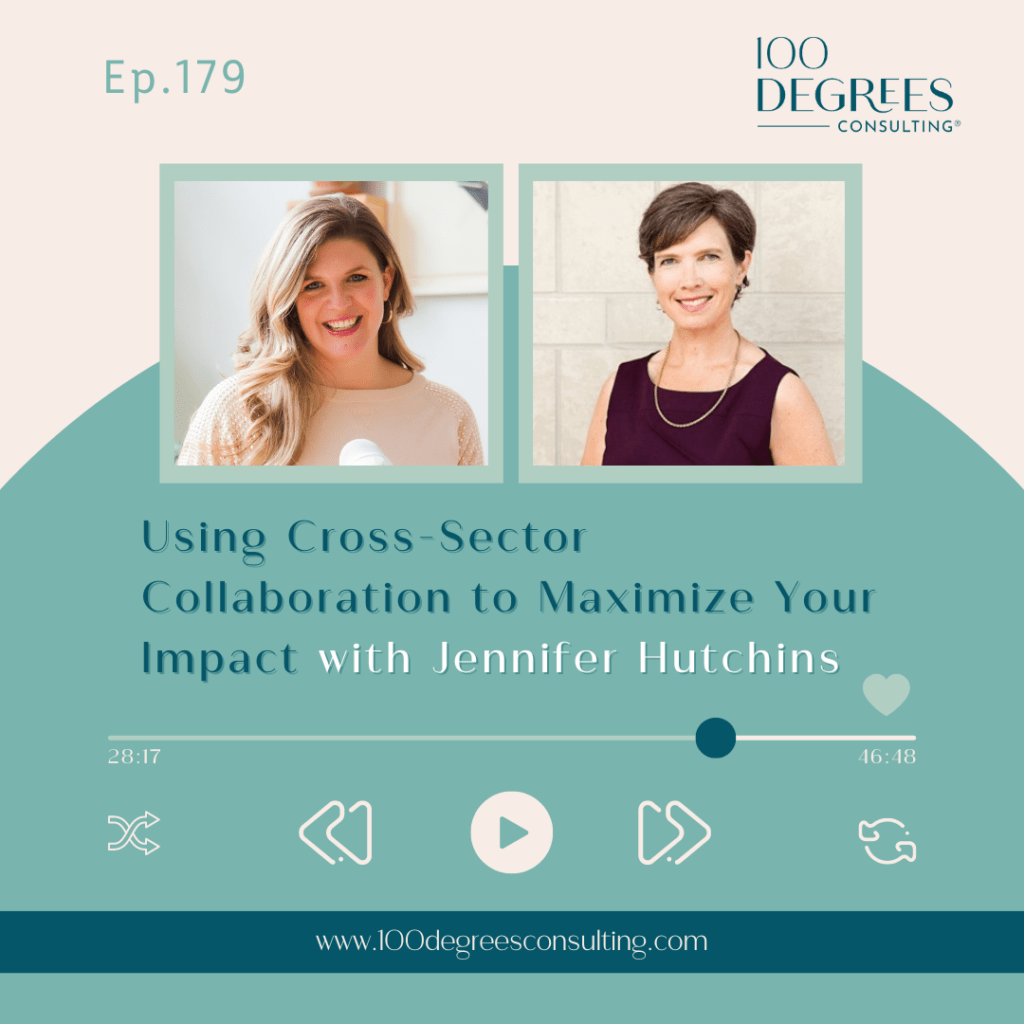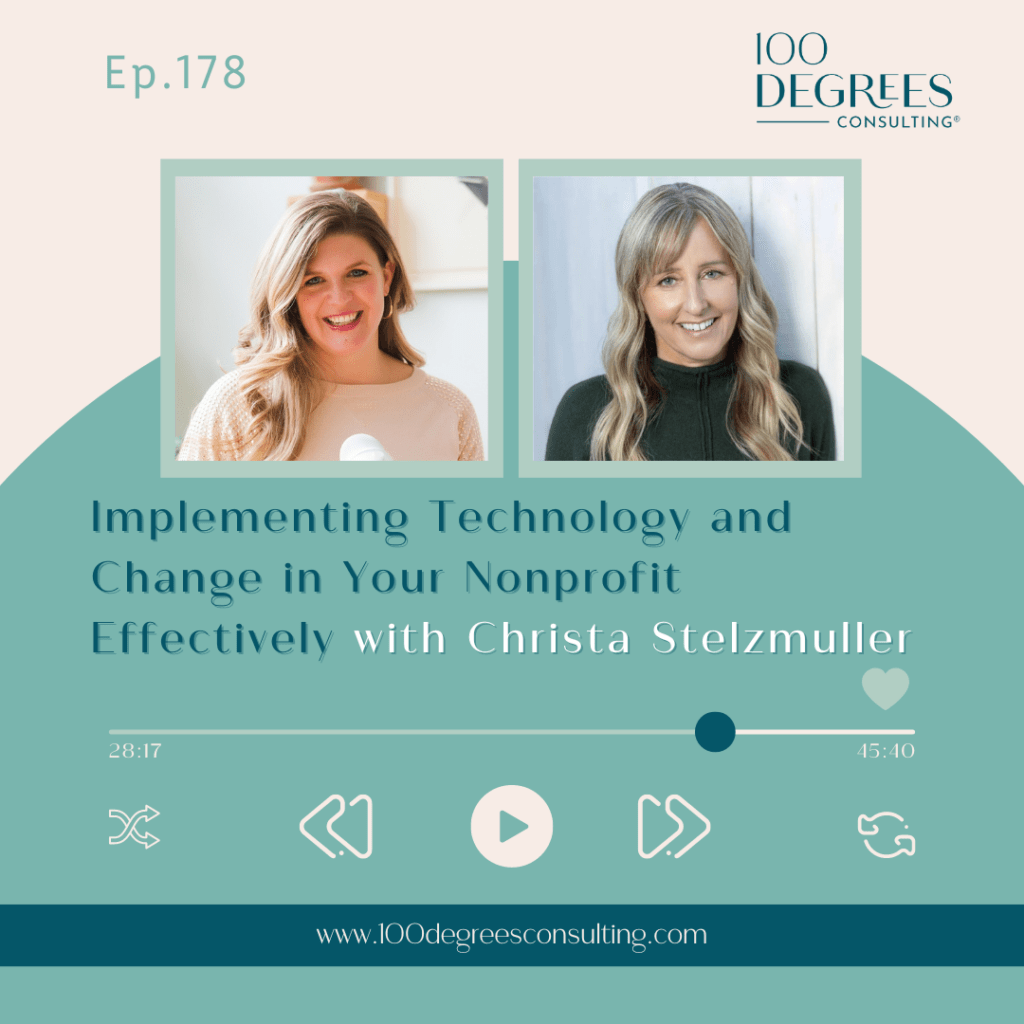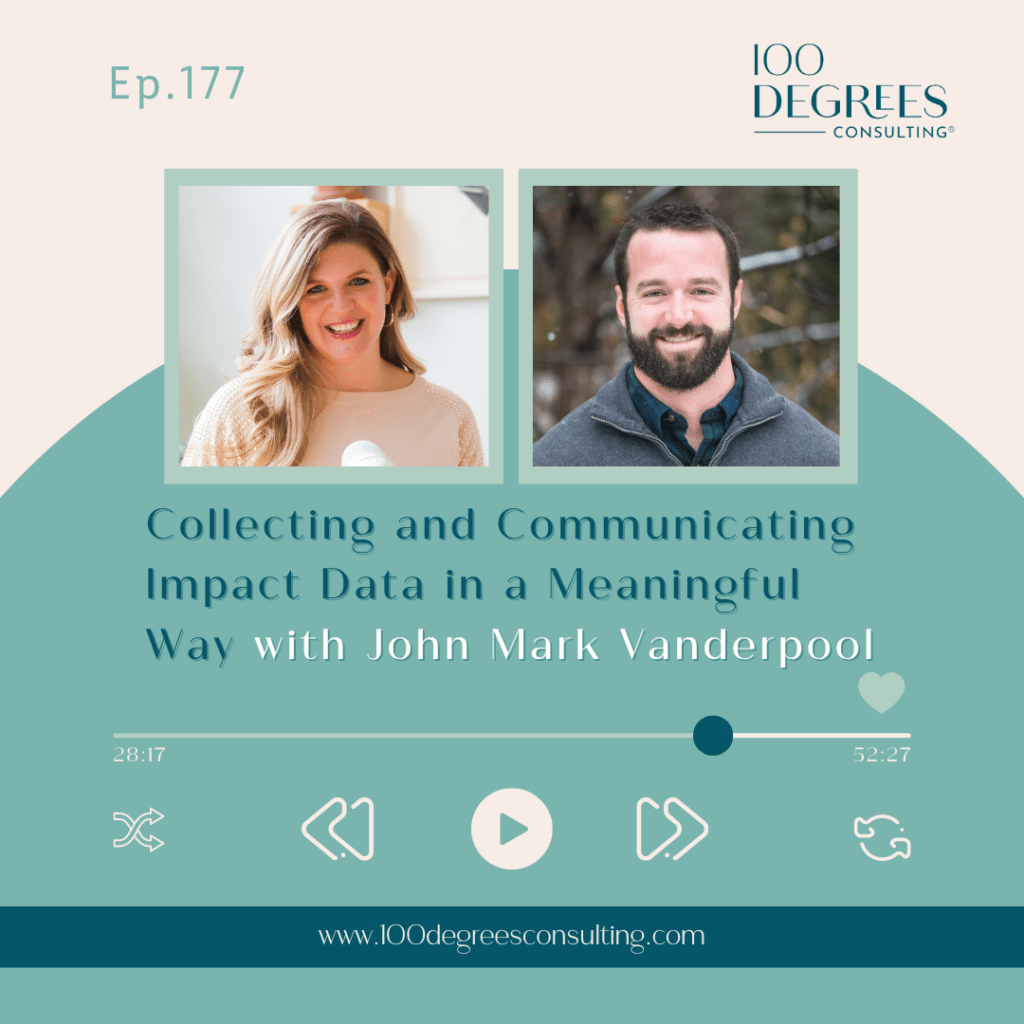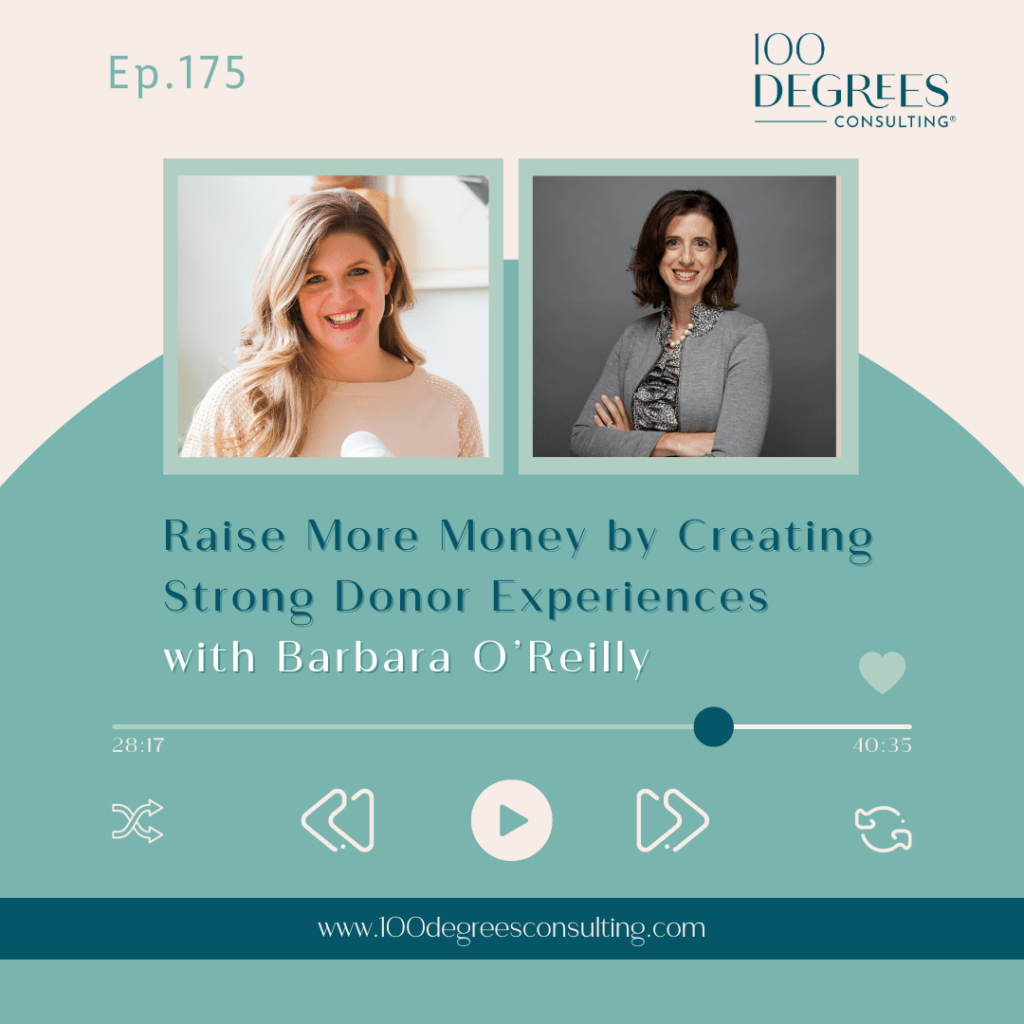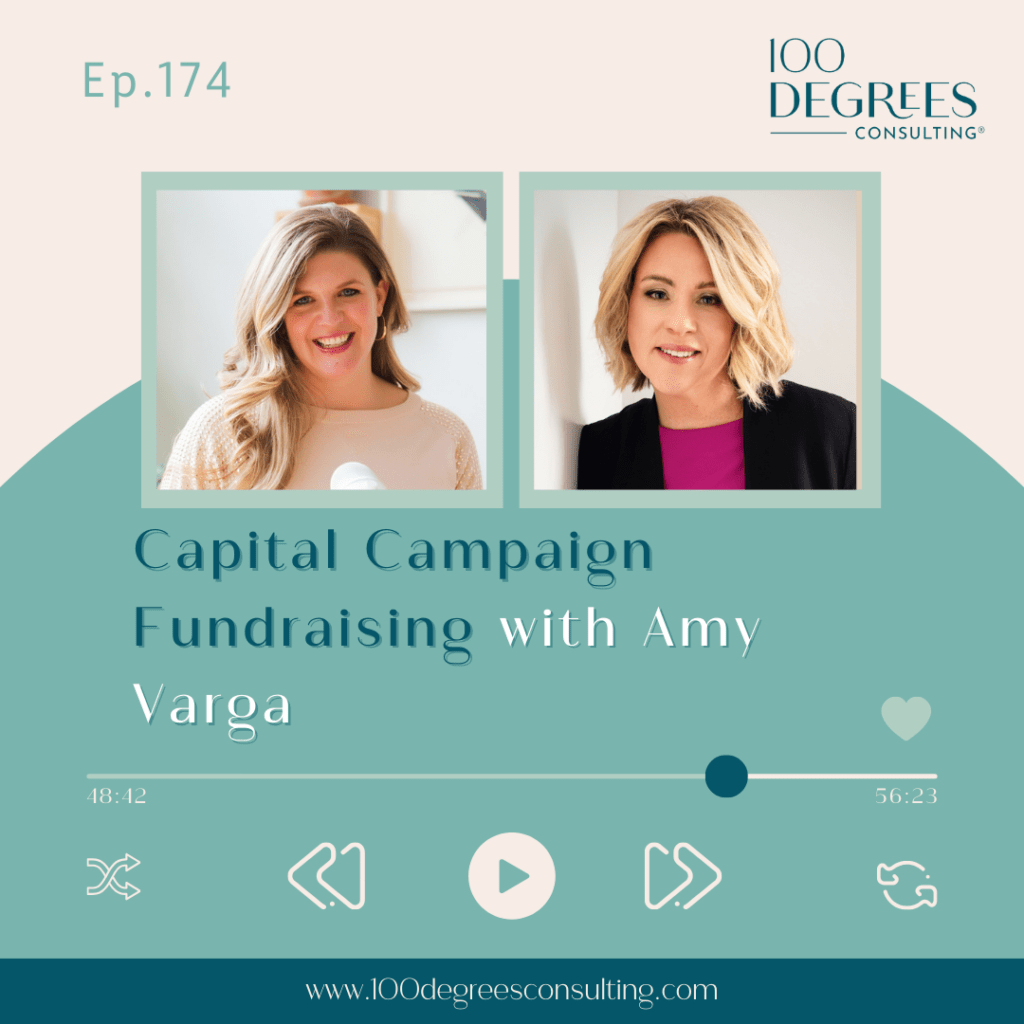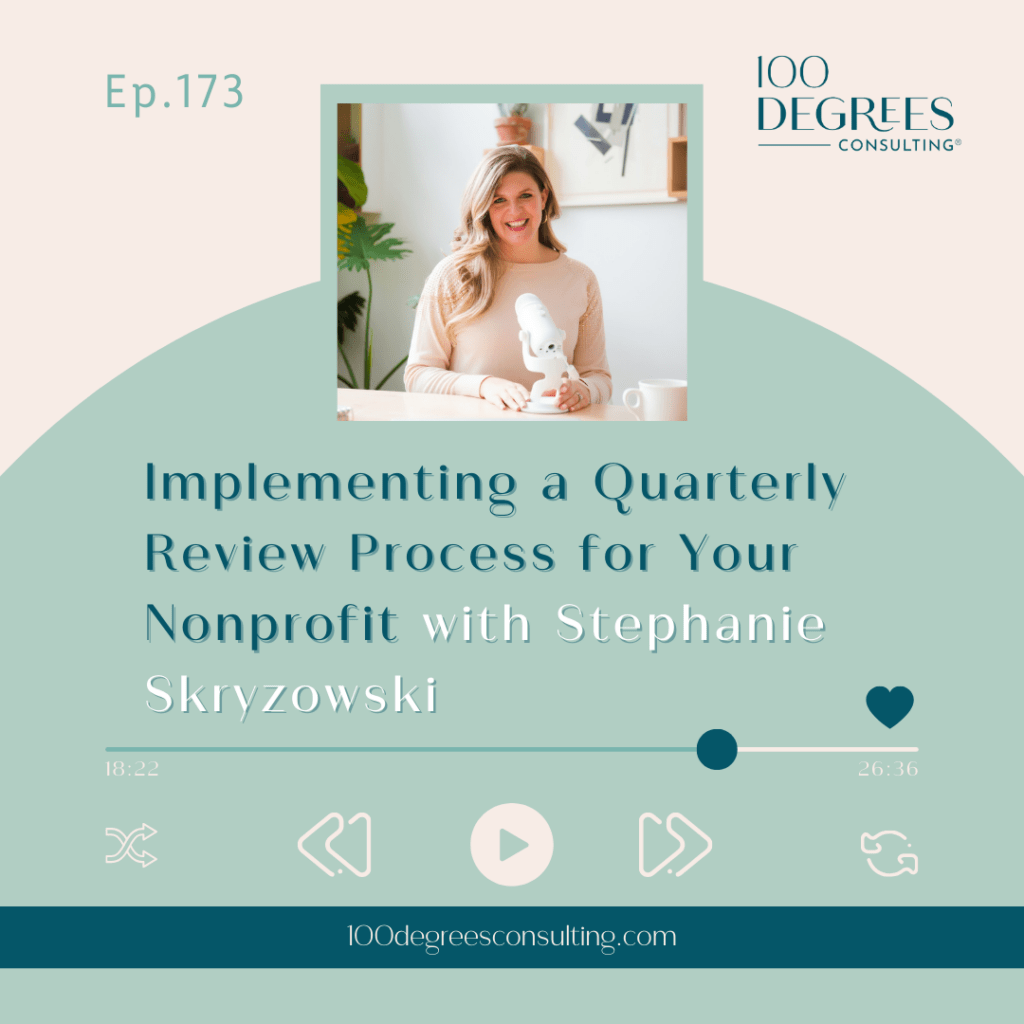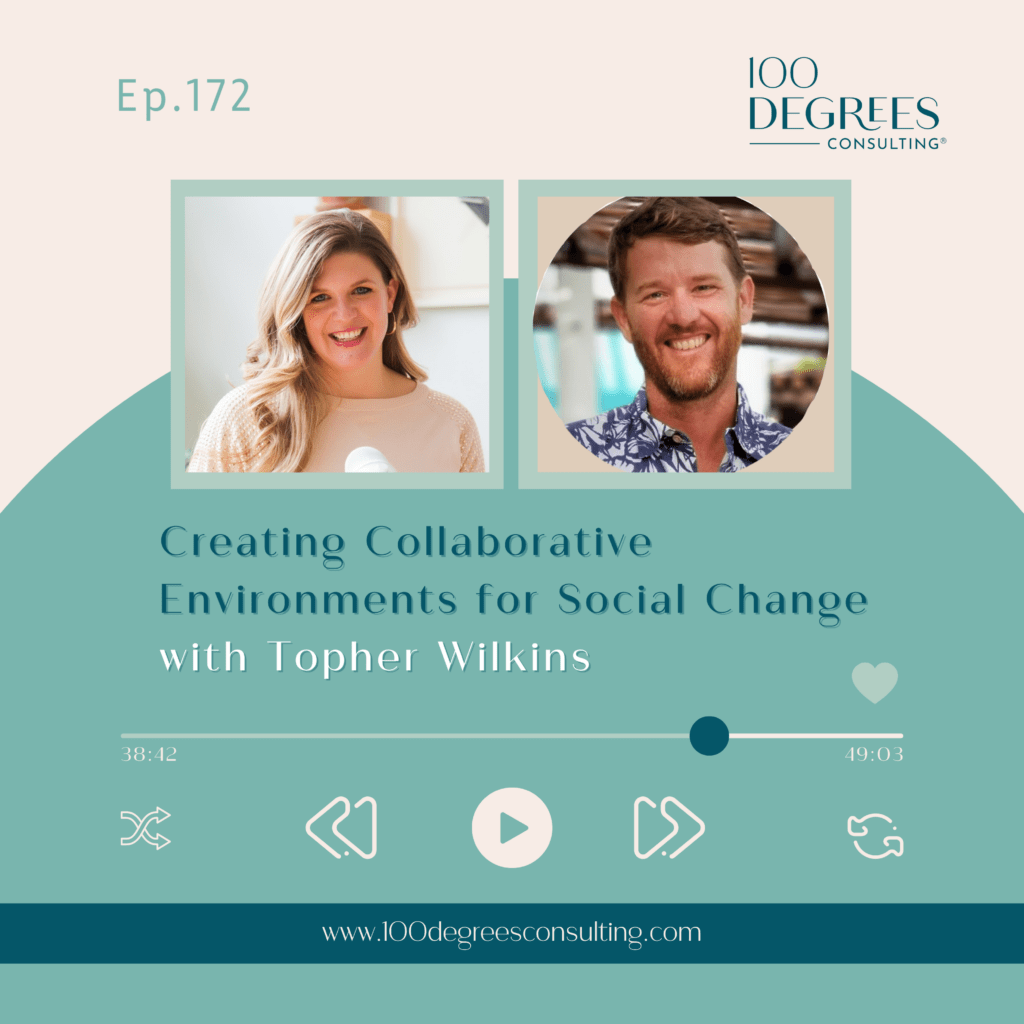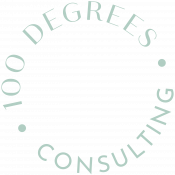Transcript Episode 174 – Capital Campaign Fundraising with Amy Varga on The Prosperous Nonprofit
[00:00:00] Stephanie Skryzowski: Welcome to the prosperous nonprofit, the podcast for leaders who are building financially sustainable and impactful nonprofits and changing the world. I’m Stephanie Skrzewski, a chief financial officer and founder and CEO of 100 degrees consulting. My personal mission is to empower leaders to better understand their numbers, to grow their impact and their income.On this show, we talk to people who are leading the nonprofit sector in new. Innovative, disruptive, and entrepreneurial ways, creating organizations that fuel their lives, their hearts, and their communities. Let’s dive in.
Hey, everybody. Welcome back to the Prosperous Nonprofit. I’m Stephanie Skrzewski. And as always, I’m so happy to be here with you today. Today, we’re talking all about It’s all about fundraising and I’m chatting with my [00:01:00] friend, Amy Varga of the Varga group who has over 25 years of experience with philanthropy, leadership and boards.
And we’re talking a lot today about capital campaigns. And this is an area that I would say I’m not like super, super familiar with as you know, many of my clients and organizations I’ve worked with have not created capital campaigns. gone through a massive capital campaign. And so she breaks it down for us, like, when should an organization consider a capital campaign?
What does it actually look like? Who are the people involved? And what is maybe not a capital campaign? And when should you not embark on a capital campaign? In which I think. Transcribed Honestly, that’s probably the most important thing to think about, because a capital campaign is not just for when an organization is like, Ooh, we want to do this big, massive project.
Let’s do a capital campaign and spend a lot of money for consultants and other people. And it turns out, well, it’s not. Um, not so great. So she [00:02:00] really helps us determine when should an organization not do a capital campaign. So anyway, we had a great conversation today. Let me tell you a little bit more about Amy before we dive in.
So like I said, for over 25 years, she’s worked with organizations throughout the world. to strengthen philanthropy, leadership, and boards. She founded the Varga Group in 2013 as a management consulting firm specializing in capital campaigns, major gifts fundraising, fundraising training, retreat facilitation, board development, and leadership coaching.
The Varga Group has guided over 100 higher education institutions, independent schools, and non profits to raise more than 3 billion. 250 million. So this woman has done it for a very long time and really understands, um, exactly what it means to fundraise on a large scale. So in addition to her credentials as a fundraising expert and a leadership coach, she’s dedicated to raising the standards of her [00:03:00] profession.
She’s a coach and a mentor to numerous peers and is a sought after panelist at conferences and on industry podcasts. And I’m going to tell you something next that was my, one of my favorite and sort of surprising parts of our conversation was her telling me that she helped launch and taught two community fundraising certificate programs in Portland, Oregon, and has taught graduate courses in fundraising and organizational strategy in the MBA program.
Um, Transcribed at the University of Portland and the MPA program at Portland State University. She also played a significant role in rebooting Portland State’s non profit institute. And the thing that surprised me, it didn’t surprise me because I had read her bio, of course, but you know, she was talking about creating.
a fundraising certificate program in, you know, where she lives in Portland. And the surprising part of it to me was that, you know, this graduate level program didn’t include anything in their curriculum around fundraising. And so she saw a huge gap and was like, all right, well, I’m [00:04:00] going to fill it. And I just think I, first of all, I love that.
You know, go getter, go getter type spirit, you know, that’s just like me as well. But it’s just so interesting because I found a similar experience when I was in graduate school and it just wasn’t super aligned with what I now know it to be like to be a graduate. You know, actively working for a nonprofit.
And so I just love that she created this fundraising certificate program. Okay. So let me just give you a little bit more about her. Before starting the Varga group, Amy held positions at a lot of different organizations. Willamette University, Santa Clara University, Clackamas Community College and Habitat for Humanity.
She’s on the board at a couple of different schools and she’s active in the National Charity League, um, in Portland chapter. So. Amy is well versed in the nonprofit, in the higher education space, and we had a great conversation today all about capital campaigns, fundraising, and I think you’re going to find it super, super [00:05:00] helpful as you’re embarking on your own fundraising journey.
So without further ado, let’s go talk to Amy.
Hey everyone, welcome back to the Prosperous Nonprofit. I’m excited to have with me on the show today, Amy Varga of the Farga Group. Amy, welcome. Thanks for having me. Yeah, I’m super excited to catch up with you and to chat and to just kind of kick us off. I would love to hear a little bit about what you do.
What is your company? What do you all do?
[00:05:34] Amy Varga: You bet. I own a small consulting firm called the Varga Group, and we do three primary services. We are campaign consultants for large capital campaigns and large major gift campaigns for nonprofits. Private schools and other kinds of 501c3s. And we also do board retreats and facilitation of those kinds of staff retreats or board retreats, any type of [00:06:00] group retreat.And, uh, and lastly, we do or I do individual coaching with executive directors and chief development officers and a very small handful of fellow business owner consultants.
[00:06:15] Stephanie Skryzowski: Awesome. Thank you. I have questions about all of these, but before we go there, I would love to hear, what has your journey looked like?How did you get to the point where you are doing this consulting work, you’re running your own business? Um, what has the path looked like to get you to this point?
[00:06:31] Amy Varga: I love that question. Thanks for asking. So this is shocking for me to be able to say my 27th year doing something in nonprofits. I’m a lifer.And so I. Uh, went to college and undergrad and, uh, got a degree in sociology, which I like to say prepares me for, um, everything and nothing. And when I graduated, I, you know, my 22 year old brain. Knew that, um, I didn’t know exactly what I wanted to do, but I [00:07:00] knew that I wanted to make a difference. And at that time, you know, my menu of options again, 22 year old thinks in a 22 year old way.
I thought it could be a teacher, you could be some type of medical provider, or you could work at a non profit. Those are the ways I thought at that time you could make a difference. And so I chose to go down the non profit route. And so I did. Started by working in some small grassroots organizations and really stumbled upon becoming a fundraiser.
And so I did that, fell into it, and, uh, discovered I loved it. And so eventually I went back to graduate school and got a master’s in higher ed administration and, uh, pivoted to doing that kind of work, um, in higher education. And so spent probably 15 years working inside of different higher education institutions doing major gift fundraising and large scale alumni relations projects.
And let’s see, I was probably, [00:08:00] whatever that would have been, 18 years in, and because probably I was sitting in higher ed where there’s a lot of teaching and that kind of thing’s happening, I decided to call up a local community college and ask them. Hey, could I start a certificate program in fundraising here?
And so I did do that, and they were receptive, and that sort of led to me teaching both at that community college, but then teaching graduate students in the MBA program. programs at two local universities here in Portland. And so I did that for about 10 years. And so I was working full time, um, at a university and also teaching in the evenings at a couple of universities and their MBA programs.
And those students in my classes started asking me, Hey, could you, you know, help me on the side with this? Or could you come in and talk to our board about this kind of thing? And so I started doing that just You know, pro bono and just kind of experimenting with it. And [00:09:00] eventually I decided to make the leap and left my, my day job, so to speak.
And that’s sort of how I got started. So that’s about 11 and a half years ago now full time. So I started doing that kind of organically probably for six or seven years. And then it took me a little while to get the courage to try it full time. And, and I did that about 11 years ago.
[00:09:23] Stephanie Skryzowski: That’s amazing. I love that you were like, I think you need a certificate program and fundraising.Can I do it? And they were like, yeah, and you went for it. Um, that’s fantastic. How did you sort of assess that that was a need and that you were the person to fill that need?
[00:09:40] Amy Varga: You know, I looked around at the MBA programs and the MPA programs and the community colleges kind of, um, continuing education. And they, you know, several of them had Nonprofit management as part of what they offered in those different areas.But when I looked at the syllabus and the curriculum, none [00:10:00] of them had fundraising, which was totally wild, you know, um, because it’s such a vital piece of the puzzle for, you know, managing and being a leader in, in nonprofits. And so that seemed really. Strange, you know, and sort of like a blind spot. And so, um, you know, I guess for me, I noticed that that was sort of like the market gap that I noticed, but then I, you know, I guess I can’t really explain, I I’ve always been, you know, the kind of person, even as a kid who just said, I’ll try that and goes for it.
And so I, I guess this was just. The next type of thing I did that with, it certainly wasn’t the first thing I’ve done like that in other parts of my life.
[00:10:45] Stephanie Skryzowski: That’s so cool. That is like super surprising that fundraising was not included in the curriculum. That seems like a pretty big missing piece. I agree.So it
[00:10:54] Amy Varga: was like, this seems like a no brainer. And I think once. Someone approached them who, you know, there’s some [00:11:00] credibility, right? So I had a bunch of years of like over a decade, you know, of professional experience and street cred. I didn’t just call up at 22 and say, Hey, I’d like to do this. Right. So I built up my expertise and I think frankly, because I had a master’s in higher ed administration, that also helped because.I was familiar with, I basically had gotten an MBA and running, you know, higher education institutions is functionally what that degree was in. And so that was useful. And I was working in higher ed. So I, Knew that landscape pretty well. So that all helped me, I think, feel more comfortable, um, you know, approaching them and going for it.
[00:11:39] Stephanie Skryzowski: I love that. That’s so cool. You know, I’ve often thought, I think I’ve even said this to somebody else on the podcast before, like I, I have an MPA, the master’s in public administration and, you know, being as far into my career as I am right now, I’m like, I’m not sure that I have used anything from that degree at all. [00:12:00] Like it feels so, and I actually, I was cleaning out my basement and I found some like textbooks and notebooks and things from my graduate, you know, uh, time there. And I was like, this feels so good. So theoretical and so not grounded in the reality of what running a nonprofit organization looks like. I’m like, we need to do better for our graduate students because it’s so like, it is not aligned with what running a nonprofit looks like whatsoever.So I’m like, I think we need to create something better.
[00:12:28] Amy Varga: Well, I, I agree. I think there’s something magical about practitioners being educators for those programs. I mean, there’s, you know, that’s. More adjunct faculty who are practitioners bring a different perspective and the blending of the academic folks with the, with the practitioner folks, I think is a really strong program because it, it makes sure that it’s grounded in reality.And I remember during that time, I would bring in stories, you know, from the day that I had, right, or what have you to class. [00:13:00] And that’s something that’s, I think really useful. And, you know, one thing, sometimes people ask me about growing my business and how that worked. And, um, teaching for 10 years was key to that because all those folks were there because they wanted to, and they were on a path to becoming a leader at an organization, you know, in my area.
And so, um, I think we all have a fondness for those that, Taught us and put them in a position of authority in some ways or expertise in a, in a sense. And so people, you know, still who were in those classes, you know, it’s so exciting to see them go and now they’re leading. So many of them are leading some of our iconic organizations in our area.
And I love, I love seeing them, you know, rise in their organizations.
[00:13:48] Stephanie Skryzowski: Yeah, I would imagine that that’s super fulfilling and I know you’re very involved in the, you know, in the organizations in the community where, where you live. So that’s so cool to be able to see that trajectory of people that you’ve encountered in [00:14:00] different parts of their journey.Going back to like, you know, you were working at a nonprofit, how did you land on the fundraising piece? With a fundraising job, your very first nonprofit job. And you were just like, let me try this. And, and it stuck. Or did you try out different things? Did you fall into fundraising? I know that happens often as well.
[00:14:19] Amy Varga: Yeah, I know. Well today now it seems like I love that. You know, our, the fundraising profession is a lot more professionalized today, you know, in 2024, but when I started it was 1997. And I think most people did sort of fall into it. And no one really even thought about that as a career path. And so I did sort of fall into it because this is so dating me, but I looked up, you know, like in the newspaper, right.And like on the job boards and things like that for jobs at that time. And so for a lot of nonprofits, it’s, you know, there’s, stating the obvious here, the administrative side, which is fairly small. And then the program side, which is really big. And that’s the core [00:15:00] of obviously the mission of organizations.
And so I didn’t have, you know, a social work background, or I didn’t have a lot of the, the professional skills to do the program work, you know, of a lot of the, you know, social service or Um, other kinds of organizations. Um, I wasn’t athlete, I wasn’t an artist or a musician or something like that. Right.
That would have led to maybe even arts organization on the program side of things. And so when I started looking at jobs in this just general nonprofit education space, I was like, well, I’m not really qualified to do the program work. I don’t have the right degree or whatever to do the program work. So what does that lead me?
And, um, you know, I had always. I’ve been a person that liked to organize things and was very involved in on my college campus with organizing different activities and things like that. And so when I saw these job descriptions that talked about. You know, creating a backpack [00:16:00] program and filling it and running events and, um, being in kind of the community relations pieces, I thought, well, I feel like I kind of know how to do that and I’ll try it.
And so my very first job, this is kind of fun, um, and probably very relatable story to a lot of people. My very first job I got. As a development coordinator, there’s an office of two, me and a development director, uh, at a domestic violence agency in the Bay Area of California. And I started, and two weeks later, the development director quit.
And so, they decided, well, Amy seems Like she’s smart and bright and eager and um, we’ll just not, you know, fill that job. And we’ll just have her report right to the executive director and see how that goes. And as kind of scary that was at the time, it’s probably one of the best things that ever happened because I just had to jump in with both feet.
Kind of let go of not knowing what I was doing because I really didn’t know what I was doing and, um, [00:17:00] and figure it out, you know, on the job. And I got to report directly to that executive director and, you know, she’s still in my, you know, kind of life network today. She’s a fundraising consultant, um, now herself.
And it’s fun to, you know, feel like she really mentored me and helped me. And that was also when I. I was like, okay, I don’t know what I’m doing besides just trying to figure it out. I also learned, uh, and I, someone probably told me, I don’t remember that there was something called, you know, AFP, the Association of Fundraising Professionals, and it was a chapter in my area.
And so I just started going to those and asking all the questions and, um, you know, kind of reading whatever I could get my hands on. And, and so that’s really how I, I got my start and, um, just kind of thrown into the deep end and. You know, the cool part was I, I really loved it. I liked it. You know, I could have been thrown in the deep end and not, you know, but I did.
And so that was, that was how I got my start and, [00:18:00] um, and then I just, you know, kind of took it from there.
[00:18:03] Stephanie Skryzowski: I feel like that’s a story that, like you said, I think a lot of people can relate to. We often get thrown into roles and in some ways it can be really challenging as people Especially if you don’t really like what you’re doing and you’re sort of thrust into a leadership role and you don’t have the skills and the ability, like, that’s one thing.And also I feel like nonprofits often afford us amazing opportunities that we would not have at, you know, larger corporations or. Organizations that are not operating with such sort of like a grassroots structure. And so you really can expand your skills and advance and grow really quickly because those opportunities are there.
We’re trying to make the most of limited resources. And so we’re, you know, you’re easily able to jump up. And I feel like, you know, to some degree, that’s how, uh, I was able to sort of be thrust into a CFO position, and I not, not sure if I necessarily felt ready [00:19:00] at the time, but it was like the stretch that I needed to, you know, to really push myself and continue to grow.
So I, um, I love that you had that. That opportunity. And so today, the, you know, when I asked about what you do today and what your company does, the first thing you mentioned was campaign consulting. So can you explain for our listeners? If they’re like, what does that actually mean? What is that? And when would an organization know that they need to hire somebody like you to help them with some sort of fundraising campaign?
[00:19:32] Amy Varga: Yeah, that’s a great question. So, and just to be clear, I am not a one woman show. Um, that would be way too many, too much to handle this by me and my team is incredible and I’m grateful for them. Um, and could never do what I’m doing by myself. So we handle about between 10 and 20 campaigns at a time just in terms of scale.So we’re kind of a mid sized consulting firm. We’re not one of the big nationals and we’re not. You know, handling one at a time. [00:20:00] So capital campaigns are, this is something I’m super passionate about. So I’m super excited to talk about it. I think that when an organization is in a growth zone, when they want to grow their impact, grow their programs.
They’re going to need to also grow their operations and their staffing and also potentially their facilities to grow all of those things. And so that’s what a capital campaign really is about. Sometimes I think people. Misunderstand it to be a building campaign. And I think that’s a misunderstanding of the real purpose behind what a capital campaign really is.
It’s a growth initiative for an organization. And so sometimes that includes a growth of your facilities or the physical assets that you need to deliver your programs. And sometimes it’s not sometimes, you know, programming, depending on what your programming is, just needs more people involved, [00:21:00] but usually when you have more people You also need more space.
And if you’re serving more people, um, you need more space. And so those things usually intersect with each other. And so when an organization is on the growth path, that’s when they likely need some help. And that comes in a lot of different, you know, ways, I would say. They would need your help, right? And your team’s help.
They need help figuring out how to grow their financial management and the, the dollars that make that possible. And there, you guys are a key partner in helping organizations on a growth trajectory. We’re a different kind of partner and we all have to, we sort of, um, all come around together. So you need a financial partner in my view, when you’re on a growth journey, you need a campaign consultant that helps you understand, um, How are you going to fund it?
What are the different components of that funding? And, um, how does philanthropy play into that? If indeed you need, um, a new facility or an [00:22:00] expanded facility or expanded physical assets, then you’re also going to need some other kinds of partners. You’re probably going to need a financial institution that’s going to be able to help bridge financing for you to do that.
They also might. Want to just finance, you know, organization attempts want to finance that. So long term financing is something that financial institutions can help you with. You’ll also need an architect, uh, you know, to help you plan the space and how much space and what that space looks like. And then of course, you’re going to need a contractor who, you know, helps build it for you.
And sometimes, uh, organizations that are, I think, smart, um, my bias is that they also hire something called an owner’s representative, which is someone that organizes, uh, the All the players to, um, instead of them trying to organize all those external partners. And so that owner’s representative oversees, um, kind of the project, um, as a whole.
So there’s actually a bunch of us kind of [00:23:00] external partners that come around organizations when they’re on a growth initiative and working on a capital campaign or campaign of some sort that help organizations think about it and be strategic and do the planning work. Our piece is around the philanthropic dollar strategy.
So I tell organizations all the time, if you don’t have to fundraise, you might want to consider that. So if you have a bunch of reserves or equity of some sort that you can draw on to self fund it. That’s ideal, right? If you can build up that kind of reserve base, that’s ideal because you don’t have to pay for counsel to help you.
Fundraising isn’t free, you know, the, the act of doing fundraising is expensive and, um, and you wouldn’t have to have any kind of lending relationship that come with, um, you know, the interest that comes with that. Most of the time organizations aren’t in a position to fully fund their projects, [00:24:00] and so they need to have a combination of sources.
They may have some resources of their own, they may do some long term financing, they may have public funds that they access for certain aspects of the project, and then usually there’s a component that’s philanthropic, so from individuals and foundations mostly. And so that. That puzzle piece is what we’re experts in, is helping organizations build a strategy.
And identify who those folks are that can be their best prospects for that puzzle piece of the bigger project.
[00:24:37] Stephanie Skryzowski: Interesting. And are you, um, as part of your work, are you going through an organization’s existing donor base or are you also prospecting outside of their sort of existing network? [00:24:51] Amy Varga: So capital campaigns are always the fundraising aspect of capital campaigns are always built.It shouldn’t say always [00:25:00] asterisks. Maybe there’s like, you know, a kind of oddball exception, but let’s assume. We’ll put that aside. They’re 99. 9 percent of the time built on strong annual fund programs that already exist and they’re inside out and top down. And so that means that you are not going to find Oprah Winfrey and get a hold of her and have her give to you what you’re trying to do.
is, and this is a piece of the service that we provide, is analyze your database of existing supporters and find that there’s this Oprah Winfrey person that’s been giving you 20 bucks a year, you know, for the last 10 years, but wow, she seems to have a lot more capacity. And so how do we reach out to her?
And how do we build a relationship with her? That’s a puzzle piece that we do help with. And actually, really what you’re looking for is organizations, this whole thing we’re talking about right now, the jargony type of term for this [00:26:00] is called a feasibility study. And so a feasibility study, um, a lot of people have heard that term and maybe don’t know exactly what it means, but essentially what it means is assessing two things, the internal readiness and the And capacity of an organization to fundraise at a larger scale and an assessment and analysis of do you have the donors and the relationships with the donors to fund what you want to fund or not.
And so we look at both things. So, you know, we look at, do you have enough staff? Do you have the technology and the systems in place? Or how could you get them in place to, you know, have the capacity to facilitate fundraising at a much higher level? We also look at that question you asked, who are you already in relationship with that you could, um, you know, talk to about this project that [00:27:00] would help make it possible?
And so one thing I feel very passionate about is that sometimes consultants, you know, we don’t, we aren’t as direct as I think we should be. If anyone’s listening and thinking about doing a campaign before you pay one cent to me or anyone else to do any of what I just said, just take a piece of paper out.
Write down one through 30 on that piece of paper, and then write down the names of people that are already giving to you that you already know how to reach and are in conversation with put them down that can make big gifts. And you think likely would, you know, be inclined, if so, you know, motivated and convinced that this project was important.
Um, if you can’t make that list, you don’t need to pay me or anyone else to tell you what we would tell you at the end of a, you know, 30 or 40, 000 feasibility study that, hey, you [00:28:00] don’t have the right people or you don’t have enough relationship with them. Anybody that comes to you and says, we’ll help you go get in touch with Oprah Winfrey or whoever the Oprah Winfrey’s are in your community.
That’s just not how it works.
[00:28:14] Stephanie Skryzowski: That’s super interesting. So the feasibility study is sort of like a little bit of a test that you have to pass before you move on to actually going through with it. Because I would imagine if the results of the feasibility study are showing that like, okay, y’all do not have the connections, you do not have the existing donors to make this successful.Um, Does that happen and do organizations kind of, like, stop there? And, and then is there, like, you know, if you sort of don’t pass this test, um, is there work that they can do to get to the point where maybe a little bit down the road they would be ready for a larger campaign?
[00:28:51] Amy Varga: Great question. We like to say that it’s a how, not an if.When we’re working with organizations on campaigns. So what that means [00:29:00] is that how you currently thinking of, are you currently thinking about it might not work or at least not work right now. And so this is where, um, you know, so then we can come up with different strategies, maybe you need to take a year or two to develop their relationships with folks, maybe the analytics showed.
You have a lot of capacity in your database. We’re actually working with an organization right now that this is the case. There’s a lot of capacity here, but you are not that close to these people yet. And so, none of us know, you know, I don’t have a crystal ball, neither do they. Will some of these high potential people have a crystal ball?
be interested in deepening the relationship. All you can do is try to cultivate and qualify those people. And so they’re spending the next year under our guidance with, you know, very specific engagement strategies and qualification strategies to see if people, you know, [00:30:00] will be interested in leaning in and hearing more.
And then we’ll assess again at the end of that. What happened? Yes. Wow. All these people that have, you know, been long time loyal folks, but haven’t yet made major gifts or major gifts at the size that would be required for your success of your project. Maybe they will be more motivated and engaged and be willing to do so after a process of, you know, engaging with them.
Sometimes it’s a phased approach. Sometimes you can say, look. You can’t do the whole project. We don’t think you can do a whole project in one shot. We think that you could do this part of the project, um, and chunk it off into different phases. And so that’s another way that you can still fulfill the goals of, you know, what you’re hoping to do, but in a different way on a different timeline.
I would say, How would I say this? People reach out to me all the time, and I have to say, [00:31:00] gosh, I think that you are really quite a ways away from being ready as an organization to take on something like this, and I provide them with a ton of resources and information and do a lot of work. Gratis explaining to them and their board, um, why that’s the case.
And so that’s one piece when we take on a client, we’ve already done that kind of assessment that we think they can be successful in some way, you know, what that exactly looks like in the end. Kind of not clear, right? We have to go through the journey with them to figure that out. So we’re not working with organizations.
We don’t, we don’t let them hire us, I guess. We don’t let them waste their money. I would say, unfortunately, some consultants do. Um, but we don’t, we, um, that’s important as a kind of an ethical and integrity thing for me is to tell people upfront so that they can spend their money, building their capacity and doing all the things, [00:32:00] um, versus paying me to tell them what I.
I was
[00:32:07] Stephanie Skryzowski: just, yeah, I was just thinking as you were saying that I’m like, yeah, a good consultant will tell you, no, like, please don’t hire us. This is not the right fit for many reasons. And yeah, that’s just for anybody listening. It’s actually a good thing. If a consultant tells you, no, you know what, this is not right.Are you tired of navigating the labyrinth of software options, wondering what works best together and how to afford it all? It is a dizzying task from choosing the right accounting software to ensuring seamless integration between all the systems, feeling lost in the jargon, Fear not introducing the best tools for an efficient and prosperous nonprofit.
This free resource is a curated collection of top notch software solutions personally endorsed by our team at 100 degrees consulting. Visit 100degreesconsulting. com [00:33:00] slash tools to access our handpicked list designed to streamline your operations and boost your nonprofit success without Adding a ton of extra cost or extra team.
Don’t miss out. Head to 100degreesconsulting. com slash tools now to download the best tools for an efficient and prosperous nonprofit. Let’s elevate your nonprofit to new heights.
So for our listeners, if they’re like, well, I want to raise a bunch of money. Like I want to do, I have this big project in mind. Is there a sort of level of growth at which it’s beyond just year over year growth and it becomes a campaign. So, you know, if an organization is growing like 20 or 30 percent year over year, That’s not really a campaign and that’s just sort of year over year growth.
But is there like a threshold at which, you know, like, Oh, we, you know, if we want to do [00:34:00] this thing and it’s going to, um, you know, we would need to double our revenue. Is there like a threshold at which organizations are like, okay, this is not really just incremental growth anymore. This is a campaign.
[00:34:12] Amy Varga: Yeah, that’s, there’s two pieces that I want to respond to from your question.I’ll respond to that. One that you just asked, but I don’t want to lose something over here. So. I would say, and this is defined, I would, not by a number, you know, an exact number, but something that’s transformative to the organization. Something that is going to truly transform the organization and its impact is when a campaign is successful.
Um, called for the way that I like to think about fundraising is that your annual fundraising, your annual operating fundraising are little C campaigns. Great fundraising is always done in the context of a campaign. Usually they’re little C campaigns. You know, you’re having an end of the year campaign or you have a little campaign for, you know, um, [00:35:00] a new roof on something or whatever it is, right?
Like it’s, these are little C campaigns, but when it’s a big C campaign, that’s when we get involved and that’s what we’re, we help organizations with. And little C campaigns, you don’t usually need all the other, you know, financial manager, consultants, the banks, and Contractors and, you know, all the architects and all that kind of stuff, those, those things are little C campaigns.
You don’t, you don’t really need those other aspects for those. The big C campaigns are the ones where you’re doing something truly transformative. Maybe you’re buying a building for the first time, you know, you’re going to own your own building, going from leasing to ownership is a huge transformational moment for.
For organizations significantly expanding your operations in some way, or your staff in some way, um, taking on maybe even a new element to what you do, you know, [00:36:00] expanding your mission in some transformative way. Those are all the kinds of things that would warrant a bigger kind of big C campaign in my mind.
I also don’t want to lose those when you said, the way you phrased the question. It’s really important that we acknowledge something you said something like if organizations are thinking we want to do this, that is something that I always want to call out if an organization wants to do it, that’s not the right reason and it won’t go well community has to want you to do it.
And the community has to need you to do it. If you want to do it, you can hustle 50, 000 or a hundred thousand dollars, right? You should still be doing it out of a community based reason, but let’s say you weren’t, you can hustle something, but [00:37:00] if you’re trying to raise, you know, millions of dollars. It can’t be because it’s something you want to do.
It needs to be something the community wants you to do and the community needs you to do. And that’s the complete basis for your case for support. The case for support is never, never, ever a good one. We want to do this. It’s the community needs us to do this. And therefore donors and foundations We need your help because the community needs this.
The community is telling us that they need it and we need you to help make that possible. That’s what a strong case is about.
[00:37:44] Stephanie Skryzowski: Hmm, huge distinction there and just think about the shift in messaging the way that you said that in the way that you would then speak to your potential supporters of your campaign.The community, not just like, Hey, we want to do this cool thing as an [00:38:00] organization, as some sort of, you know, I don’t know, ego trip situation. No, like the community needs this and we need your help in supporting this. So. I love that. That’s a huge distinction. And I would imagine that’s something that you can sort of suss out as you’re talking to potential clients as, or organizations as well.
Like, is this happening for the right reasons? Is there a community need? Is there a community desire for this? Versus like, we want to do this cool thing. I imagine you can probably find that out quick.
[00:38:29] Amy Varga: Yeah, usually capital campaigns are big campaign initiatives. The best way that they emerge is through strategic planning, you know?And so what happens is, is that, you know, a well run strategic planning process is not an inward looking thing. It’s an external engagements planning process. And so I think that’s something that’s, I think always been true, but I think that more and more organizations and. Themselves and [00:39:00] also encouraged by foundations are orienting their strategic planning to understanding the needs of the community and how they serve those needs.
And they do their strategic planning goals based in the communities engagement around their strategic planning. And then the internal part is, you know, how do you, what do you need to operationalize what you’ve heard the community needs through that strategic planning process and how, how are you going to, um, you know, operationalize that for your organization?
And out of that, if a piece of it is we need to expand our program, or we need to expand our staff in order to expand our program, or we need to have new facilities to do all of those things that’s in our strategic plan, then that’s, that’s the rationale for doing any and all of this. Mm hmm.
[00:39:54] Stephanie Skryzowski: That’s huge.I’m so glad you like caught that, what I said, not that I said that on [00:40:00] purpose. Um, but I’m glad you caught that and sort of explained that, that nuance. Cause I think that’s really important because I would imagine that it can, I don’t know, for a nonprofit leader thinking like, oh, let’s do this. Let’s do this big thing and raise a whole bunch of money.
That’s very exciting, but it needs to, you know, there are things that we need to do to make sure that we’re doing it for the right reason. So that’s awesome. Um, great. So I wanted to just chat a little bit. You’ve mentioned a couple of times. I’m going to If you are embarking on a large campaign, all of these different people and you very succinctly laid out all of the different roles that might be involved in a campaign.
And I’d love to circle back to the finance person. Um, obviously, you know, my, my company provides the finance services, but I will say, I don’t think. I think a lot of our clients have gone through any sort of major campaign like this. And so I would love if you could share a little bit about the sort of intersection of financial planning and campaign [00:41:00] planning.
[00:41:01] Amy Varga: You bet. So the way I think about these capital campaigns and these growth initiatives from a financial perspective is. There’s two parts. There is the obvious part, which is how are we going to fund this stuff we want to do, right? So, let’s say you want to build a new shelter for cats, and you want to have an expanded veterinary service program in that, as part of that, and you want to, um, You know, you need more staff in order to have the people power to run that expanded shelter and the new veterinary services.Let’s just say that as an example. So the obvious thing that people look at is, and it’s going to cost you 8 million, right? You figured that out. So the obvious thing is to figure out, or is to ask. How are we going to get this 8 million that we need? Right. And so, again, you can look at a bunch of different funding [00:42:00] sources, you could look at public funding, depending on what your mission is, you may have new market tax credits, you may have public allocations you can get.
You may have, you know, foundations, institutional foundations from philanthropy, individuals from philanthropy, maybe even corporate, um, although that’s much less common in, in capital campaigns. And maybe you have, you know, a million bucks that you have in reserves that you could put towards it and you feel like your organization could, um, sustain, you know, a million dollar loan.
Um, so that means. Put all those puzzle pieces together to get your 8 million, right? That’s that’s the obvious thing that people think about. And that’s good that they’re thinking about that, obviously. So that’s one of the pieces. The other piece that I think gets a lot less airtime and a lot less attention and frankly is maybe more important in some ways, at least equally important is [00:43:00] long term financial planning.
There’s never been a business, non profit, for profit, right? That has grown. And cost less to run your operational growth will be, um, part of your annual operation growth will be part of what you have to attend to. So while you’re figuring out your 8 million project, in this example, you also have to figure out.
Okay, our operating budget, let’s fast forward and assume we get the 8 million and we’re successful and we have this bigger, you know, facility and these bigger programs and a bigger staff. How much is it going to cost to run our organization three years from now? And that’s called, you know, future budget planning, performa, right?
Which is like a fancy word, a jargony word for a pretend future budget, you know? And so I always like to say, it’s sort of like, you don’t want to go buy the house like, Oh, I can figure out, we can [00:44:00] put the down payment down and we can get it. But then, oops, we bought the house and now we realize we can’t actually furnish it or pay the bills, you know, every month.
And what I would say is that people, when they’re coming to me, and I think a lot of other capital campaign consultants, they’re almost universally focused on the 8 million question. And I’m very passionate about them also putting equal attention on proving to themselves and doing the financial planning.
And that’s where I think, you know, a team like yours can help them test out, you know, Even some of the questions in the 8 million. Well, how much debt could we handle? Right? That’s a question of financial management and your operational management. Um, but even if you don’t take on long term debt, you still have to know we’re going to be able to survive.
There’s so many, um, I think the worst case scenario would be. [00:45:00] Yay, we built a thing. And three years later, we go out of business because we actually can’t sustain our new expansion of operations. And so that’s where the deep partnership between financial planning on an operational side needs to be integral to the process for the organization.
Also is in a very important ingredient in securing large donations because, you know, the people that are going to give you those major lead gifts, they’re wanting to ensure that their investment. is not going to something that’s going to close in three or years. And so, first and foremost, it’s for the organization to make sure it can sustain itself and doing the, um, you know, future planning work to substantiate that for themselves.
But it’s also an [00:46:00] important thing to do so that you can speak to that It’s just, uh, to your potential lead and major donors to encourage their investment in the project itself. Mm hmm.
[00:46:13] Stephanie Skryzowski: That is so important. And it sounds like when you’re listening to it, if somebody listening is probably like, well, yeah, that sounds obvious, but I have seen this so many times where organizations and not even related to a campaign, a campaign, I feel like it’s just this, but on an even bigger level, but I’ve seen organizations be like, well, you know, we’re having a really good, um, year in terms of revenue.So let’s hire a bunch of people because we have extra money in the budget. Well, Yeah, that’s great. Maybe we do this year, but like, what is the full year impact of this person’s salary and benefits next year? Do we have, if we got a bunch of, you know, one time revenue this year, what are we going to do next year?
When we still have to pay this person’s salary and benefits, are we going to lay them off? Like, that’s not really [00:47:00] ideal. And so I have seen, I’ve seen that happen a lot where we’re not. Thinking about the future impact of investments and of expenses that we’re incurring today. And so I think that is, yeah, that’s just such a good point.
You’re right with expansion comes expanded operating costs and. That, you know, it’s only going to continue to grow. So I love this idea of putting together a multi year, you know, budget, forecast, pro forma, whatever you want to call it, but a multi year financial plan, um, before you embark on this huge project.
So yeah, that is super smart. We require
[00:47:38] Amy Varga: it of our clients because our commitment is that, um, you know, our sort of promise that we deliver on, right, is that we will help you raise the money you need for this project. Um, and we’re going to help you grow your fundraising in the future, ever forever more.You know, so yes, we’re going to help you, you know, raise the 8 million or whatever in that [00:48:00] example. But we are also going to elevate your fundraising forever more after your campaign. And that’s, um, in part because you’re going to need it because you’re going to need more operating dollars. And so fundraising needs to grow in order to support that.
And, and other things like in this example, playing it out, you know, if you have more veterinary services, you also have. More revenue from those veterinary services, like there’s things right? You have to. I’ll think about all of the elements, but everything needs to grow in relation to your expanded operational costs, including your fundraising.
[00:48:40] Stephanie Skryzowski: Mm hmm. Yeah. Yeah. That’s so important. And you know, that’s why I, I think it’s really important for fundraisers to also understand financials and understand the importance of fundraising. Forecasting and budgeting appropriately. And, you know, I, I don’t think it’s okay for fundraisers to be like, well, [00:49:00] you know, I’m a fundraiser finances spreadsheets, not really my thing.Like it kind of has to be your thing, because if you’re not the person to be creating the forecast and the budget, you need to be able to advise the organization that you work with on, you know, uh, on getting that in the right direction. So I love that as a, as a finance person,
[00:49:19] Amy Varga: I can’t agree more. I would.Put another bullet on your list of why you know it’s important is because even if you’re just thinking it as a fundraiser, it’s what your primary job is, is to be a conduit to the donors and the foundations. They are going to want to know the answers to those questions, right? Like no one’s going to give you a million dollars if you can’t tell them that and prove to them, not just tell them, prove to them, right?
That their money is going to be safe and put to good use and that you’re, you have longevity. So that’s, I mean, [00:50:00] frankly, that’s why major nonprofit institutions, it’s a part of the reason why major nonprofit institutions get those big donations versus some of the scrappy, your smaller ones, because donors who have those kinds of resources know that, you know, Notre Dame university is not going out of business, but the little arts organization, maybe, right?
And so, That’s a part of it, right? I mean, it’s way more complex than that, but that is an important puzzle piece. And donors who are giving you significant gifts really do care about this. So as a fundraiser. You have to also, you know, care because that’s something your donors care about and you need to, um, you know, have that confidence and you, you have to be ethical.
You have to tell donors the truth about whether or not there, you know, is that financial stability in the [00:51:00] organization, I think. I would also add your rant a little bit about like, Oh, fundraisers, they need to know and care more. I would say it’s shocking to me when I’m around other fundraising consultants and capital campaign consultants.
They don’t understand this as much as I think they do. They should either. Um, I think that’s why we are a firm of choice for a lot of organizations. And I spent a lot of time, you know, not being paid to like really talk about, Hey, you don’t have to fund this. And actually rarely is a big capital project solely funded through philanthropy.
I I’ve had exactly one project like that in all the years. It’s just not how it’s done. It’s a combination of funding sources and. You have to get your spreadsheet together or your financial management tools together around your future budget [00:52:00] planning. Um, in fact, we, like yesterday, literally with one of our clients, we are like, we will not move into feasibility until you have done this to some degree that when you go out to feasibility and start talking to donors, we know they’re going to ask you.
So we’re not going to put you out there and we’re not going to go out there. Until you’ve done this work,
[00:52:23] Stephanie Skryzowski: just another example of how finance and fundraising need to be friends. Um, and need to need to work hand in hand. I was going to say, um, you know, this is giving me an idea for like a course or a webinar or something finance for fundraisers.I’m like, I think this needs to happen. Absolutely. I love it. Well, before we wrap up, I just have one more question for you that I like to ask all of our listeners. Um, what does a prosperous nonprofit look like to you?
[00:52:51] Amy Varga: Oh, I love that. That’s a great question. Not so good on my feet, Stephanie. Um, I’m [00:53:00] not quite sure how to say this, but I think that an organization that’s making, Deep impact in the community along their mission and at the same time is putting the well being of their staff at the center of doing so.I think that something along those lines would be, um, you know, how I would define success. Um, and so, you know, to me. I love that, you know, um, Richard Branson quote that something like, you know, clients, I like to switch out donors, you know, but his quote is something like clients aren’t our customers aren’t the most important thing.
Your employees important thing. And, you know, I like to switch out that word, you know, sometimes. Donors are most important and a constituent group, but really it’s your staff and your employees that are, and, um, they’re the ones that, you know, make all the magic happen, including with your donors, but also with, in your [00:54:00] mission.
And so I, I love, The kind of growing awareness and commitment of our sector to talk about that and to invest in making sure that people are paid living wages and that their wellbeing is cared for.
[00:54:19] Stephanie Skryzowski: Yes. I love that. I, I could not agree more as yeah, somebody that’s worked inside nonprofits and now being, being a business owner as well.I, um, I completely agree. Well, Amy, it has been such a pleasure to talk to you. I feel like I have all kinds of fresh ideas that I’m excited to think about and bring back to clients. Um, where can our listeners find out more about you?
[00:54:44] Amy Varga: Thanks for asking. People love the website. It’s thevargagroup. com and I’m sure you’ll put a show link or something to that.It’s real important for me that I create resources for all kinds of organizations, ones that can afford us or that are [00:55:00] ready for us and ones that can’t. And so there’s tons and tons and tons of free resources there. You don’t even have to give me your email address. You can just go on there and grab them.
And so that’s a great place to go. And I also seem to have a lot of fans on LinkedIn. And so you can look me up just at my name, Amy Barka, and I share some of those resources and all sorts of other things there. And I’d love to connect with anybody who wants to do so on LinkedIn.
[00:55:27] Stephanie Skryzowski: Fantastic. Thank you so much.Um, yeah, I just popped over to your website right now and holy moly, like you can probably find a resource for like everything that we’ve talked about today on here. So this is fantastic. Thank you so much for sharing. Um, yes, we will definitely link to the varga group. com in the show notes. And then it’s very easy once you’re there to navigate to resources and there’s a lot of good stuff on there.
So Amy, thank you so much for being here and sharing all of your wisdom with us. Appreciate it.
[00:55:55] Amy Varga: Thanks for having me. I’m so glad you’re in lots of organizations corners around their money. It’s so important. [00:56:00] [00:56:02] Stephanie Skryzowski: Before you go, I just want to thank you for being here to access our show notes and bonus content.Visit 100degreespodcast. com. That’s 100degreespodcast. com. And I’ll see you next time.




